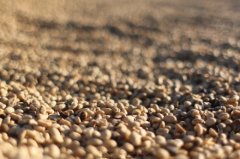Cultivation techniques of small Coffee in Yunnan Province Coffee Tree Disease Control

1. Coffee rust
Is the main disease of coffee, the most harmful, the damaged plants, light reduced yield, heavy death. Coffee rust is mainly harmful to leaves and sometimes to young fruits and twigs. After the leaves were susceptible, many light yellow spots appeared at first, and expanded in the shape of water stains, and then there was a pile of orange-yellow powdery spores on the back of the leaves, and there was a light green halo around the disease spots. In the later stage, the disease spots gradually expanded or linked together, becoming irregular disease spots, and the disease spots finally withered, showing dark brown, and the whole susceptible leaves fell off.
Prevention and cure method
① was planted with rust-resistant varieties. Quarantine work should be done strictly during introduction to prevent the spread of germs.
② strengthens tending management and improves plant disease resistance.
The pathogen was cleared by ③. The seedlings in the nursery should be inspected frequently to remove the diseased leaves; the plants in the coffee garden should be pruned to remove the weak branches and diseased leaves, especially before the end of the dry season, and all the diseased leaves should be removed immediately as soon as they are found. and combined with chemical control.
Chemical control of ④. Using 1% to 5% Bordeaux liquid spray, the first time should be before the rainy season, according to the specific conditions and the severity and severity of the disease, generally every 2 to 3 weeks spray, triamcinolone acetonide has a preventive effect on coffee rust and has a therapeutic effect in the early stage of the disease. Use 25% wettable powder 35g / mu or 5% WP 150g / mu, spray 30kg of water.
two。 Coffee anthracnose
It occurs in almost all coffee-growing areas. It is mainly harmful to coffee leaves. After the initial infection of the leaves, there are light brown spots on the upper and lower surfaces, with a diameter of about 3 cm. The centers of these lesions are grayish white and turn completely gray in the later stage, with black dots arranged in concentric circles. Infection often begins at the edge of the leaf. The disease can spread to branches and fruits, causing branches to dry up; after the fruit is infected, there are sunken disease spots that turn black, and the flesh hardens and clings to the beans. (VIII)
Prevention and cure method
(1) strengthen tending management (including reasonable fertilization and correct pruning) to create a microclimate environment suitable for coffee growth, make coffee trees grow healthily and improve disease resistance.
(2) Chemical control
① 1 ∶ 3 ∶ 100 Bordeaux liquid has better control effect.
② abroad introduced the use of 1% carbendazim in two weeks after flowering began to spray the first time, and then sprayed once every three weeks, a total of 8 times, can receive a good control effect.
3. Coffee leaf spot, also known as brown spot
All kinds of coffee can be infected with the disease. It is the most popular in cloudy and wet weather. Mainly damaged leaves, the damaged leaves showed irregular large disease spots, the disease spots were dark brown or black, without wheel lines, and withered in severe cases. Seedlings and young trees are particularly susceptible to infection, often causing wilt.
Prevention and cure method
Once symptoms are found, the garden should be cleaned immediately, the diseased leaves should be collected and burned, and 0.5% Bordeaux solution should be sprayed to protect the plants.
Important Notice :
前街咖啡 FrontStreet Coffee has moved to new addredd:
FrontStreet Coffee Address: 315,Donghua East Road,GuangZhou
Tel:020 38364473
- Prev

Cultivation techniques of small Coffee in Yunnan Province harvesting and processing of coffee beans
Timely harvest is an important link to ensure high coffee yield and improve product quality. The harvest time of small seed coffee is more concentrated, when the fruit turns red, it can be harvested. It should be picked along with ripening. After completely turning red, the fruit is easy to fall off. (9) Wet processing is generally adopted in processing. (1) washing fruit. Wash away the soil or sundries that stick to the fruit. (2) grading of fresh fruit. Green fruit, dried fruit,
- Next

Cultivation techniques of small Coffee in Yunnan Province Pest Control of Coffee trees
1. Coffee tiger, longicorn beetle. The coffee tiger longicorn beetle harms the coffee trunk for more than 2 years. At first, it eats between the cambium and xylem, and then eats the xylem. It has a great effect on coffee, the light ones make the plants yellow, withered branches and fruit drop, and the serious ones die of the whole plant. At the initial stage of the damage, there was no obvious hole in the appearance, but only slightly raised in the epidermis of the injured area. Prevention and control methods: strengthening the management of ①
Related
- Detailed explanation of Jadeite planting Land in Panamanian Jadeite Manor introduction to the grading system of Jadeite competitive bidding, Red bid, Green bid and Rose Summer
- Story of Coffee planting in Brenka region of Costa Rica Stonehenge Manor anaerobic heavy honey treatment of flavor mouth
- What's on the barrel of Blue Mountain Coffee beans?
- Can American coffee also pull flowers? How to use hot American style to pull out a good-looking pattern?
- Can you make a cold extract with coffee beans? What is the right proportion for cold-extracted coffee formula?
- Indonesian PWN Gold Mandrine Coffee Origin Features Flavor How to Chong? Mandolin coffee is American.
- A brief introduction to the flavor characteristics of Brazilian yellow bourbon coffee beans
- What is the effect of different water quality on the flavor of cold-extracted coffee? What kind of water is best for brewing coffee?
- Why do you think of Rose Summer whenever you mention Panamanian coffee?
- Introduction to the characteristics of authentic blue mountain coffee bean producing areas? What is the CIB Coffee Authority in Jamaica?

